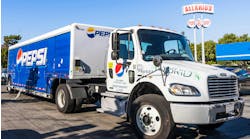WattEV, a Segundo, Calif.-based startup has chosen Bakersfield to be the location of a 25-megawatt (MW), solar-powered, electric-only public truck stop between California’s Central Valley and Southern California’s ports and shipping hubs.
The start-up, founded by telecommunications and satellite engineers, aims to solve the classic chicken-egg problem: Which comes first, electric trucks or charging infrastructure? Their solution: Do both at once.
The 110-acre truck stop, located at the southern end of California’s expansive San Joaquin Valley, will be positioned near logistics fulfillment centers run by Amazon and Walmart and will feature a solar micro-grid with battery storage as well as grid energy from PG&E.
Partners in the project include the San Joaquin Valley Air Pollution Control District, Greenlots, Power Electronics, the Central California Asthma Collaborative, heavy-duty truck makers, PG&E and others. Initial output from the WattEV electric truck stop will include 4-MW capability, eventually growing to 25-MW feeding more than 40 charging bays.
To solve the other side of the issue, WattEV has developed a business model, labeled Trucks as a Service (TaaS), that opens the transition path for transporters to use battery-electric trucks.
“We aim to enable the addition of 12,000 heavy-duty battery electric trucks to the roads in California by the end of 2030, exceeding existing forecasts,” said Salim Youssefzadeh, CEO of WattEV. “If it works in California, it’ll work just about anywhere in the country.”
WattEV, whose core business started by developing the novel charging infrastructure, has reserved its first 50 Tesla Semis and plans to place more orders with other OEMs. WattEV expects this new approach to accelerate the adoption of electric trucks in California and the rest of the country.
“Focusing on the revenue and profit potential of an electric truck, rather than the fixed and variable cost of owning a new or used diesel truck, is how we can get more drivers into more electric trucks more quickly,” added Youssefzadeh. “Waiting for the market to mature organically – at the rate it’s currently going – could take more than a decade. Our aim is to fast-track the transition to electric truck transport by doing things a little differently.”



